The History and Ruins of the Riverside Park Suspension Bridges
- Ed Fujawa
- Jun 1, 2022
- 7 min read
Updated: Sep 30, 2022
A short post about a favorite topic: Bridges in and around Indianapolis. This one was inspired by a recent visit to Riverside Park to check out the new rock ramp dam constructed on the White River following the demise of the Emrichsville Dam a few years ago. The ramp creates a pool in the river going upstream, while allowing the water to gradually drop several feet over the course of 150 yards. While observing the rock ramp, I spotted the remains of a structure (below) near the Lake Indy boat ramp which I had previously photographed but had never researched.
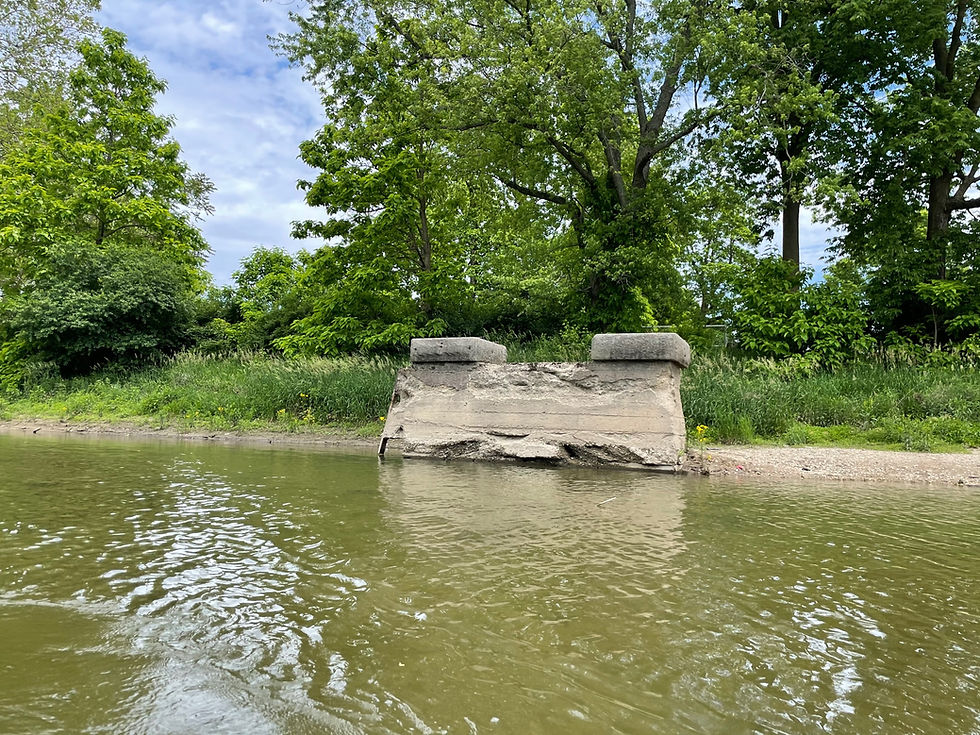
It turns out that this concrete structure is the remains of one of two suspension bridges over the White River in Riverside Park. While the Emrichsville Bridge and the future 30th Street bridge handled vehicular and pedestrian traffic, the two suspension bridges were intended just for pedestrians and bicycles.
The bridges were just a component of the grand plan to make Riverside a show piece of a park, with boulevards, lagoons and creeks, picnic areas, a zoo, and multiple golf courses. The most common image of at least one of these bridges is a postcard which is available online at several institutions, and is easily found on eBay:
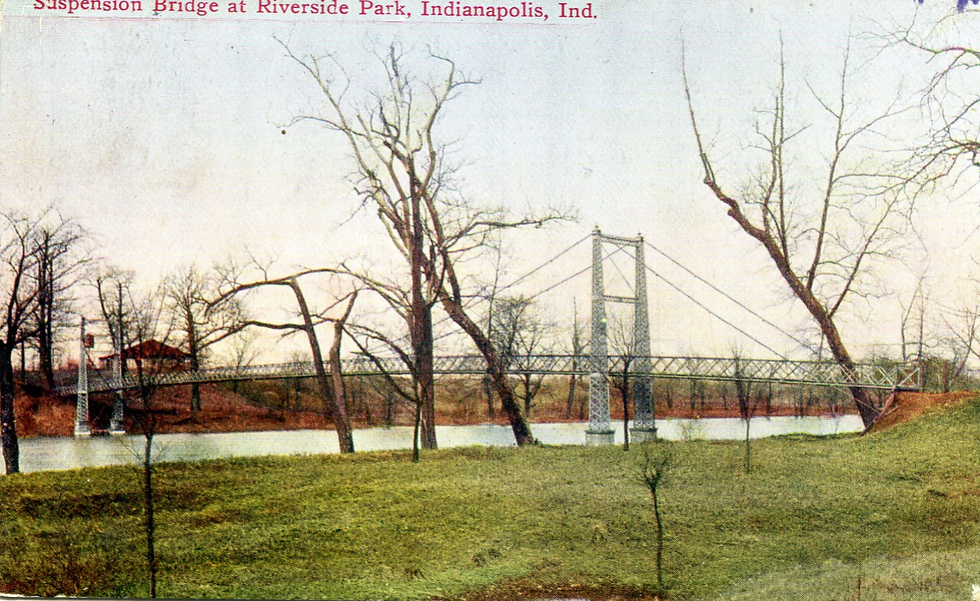
This postcard is presumably based off of a photo depicting the same scene in the digital collections at the Indiana Historical Society. It is not clear which bridge is in these images, although I suspect this is the northern bridge (near the Lake Indy boat ramp), as seen from the eastern bank, based on the relatively low ground seen on the opposite shore.

A request for bids on two bridges was issued in 1899. While early reports had indicated the bridges would be for cyclists, Park Board Superintendent J. Clyde Power told the Indianapolis Journal on June 4, 1899, that the suggestion that the bridges would be for cyclists was "erroneous" and that they would be built for pedestrians as well, while "riders of the wheels" would be required to dismount and walk their bikes across the bridges.
Bids for the bridges were first received in July of 1899, when the Indianapolis Bridge and Iron Company and Wabash Bridge and Iron Company both submitted bids for $8,960 and $8,000 respectively. Wabash won the contract and construction was begun in 1901. The first bridge was completed about a mile downstream of the 30th Street bridge, near the Indianapolis Canoe Club. This was the “Cold Spring” bridge, due to its proximity to the Cold Spring bluff area of Indianapolis, which is the present-day Municipal Gardens at Cold Spring Road and Lafayette Rd. In July of 1901 this lower bridge was noted by the Indianapolis News to have its span partially in place, while the abutments for the second had just been completed on July 11. The image below, undated aside from being taken in 1901, shows the completed southern bridge, as seen from the high ground on the western bank of the river looking upstream.

The second bridge was in between the Cold Spring location and 30th Street and was completed in August of 1901. The remnant pictured above is part of that structure, near the Lake Indy boat ramp. The Indianapolis News image below shows this bridge.

The bridges were not in place but a few years before each was threatened with what would be a recurring menace: the elements, and especially, ice. In the winter of 1904, an ice gorge, or ice jam, caused significant damage to the northern suspension bridge, as well as other park assets. Initially the damage was viewed as being repairable. However, by March the Board of Park Commissioners had decided against repairing the northern bridge.
Then in 1905 “one of the greatest ice gorges ever seen on the White River,” threatened the northern suspension bridge. On March 3, 1905, the Indianapolis News reported that the iron towers of the bridge were damaged: “The ironwork above the cement foundation which form the towers are of frail latticework, and a number of the small iron cross pieces have been twisted out of place. The water and ice completely hid the cement.”
There was concern that a large amount of ice upstream from Broad Ripple could dislodge and add additional pressure to the Riverside jam. Dynamite was utilized to try to free the jam, but this only below holes in the mass of ice and did not dislodge the jam itself. Based on the images in this post, and the descriptions of the ice jams, it seems the piers for the bridges were built too short and exposed the more fragile iron support towers to abuse from ice flows and floods.
Despite this design issue, the lower suspension bridge, near the higher ground adjacent to the new Canoe Club and Cold Spring (again, the present-day Municipal Gardens), survived and carried on longer than its upstream partner. In fact, the often-shared George Kessler map of Riverside Park published in 1913, shows the southernmost bridge, just upstream from the location of the new Canoe Club (the original Canoe Club had been next to the 30th Street bridge, where the Heslar Naval Armory now stands).
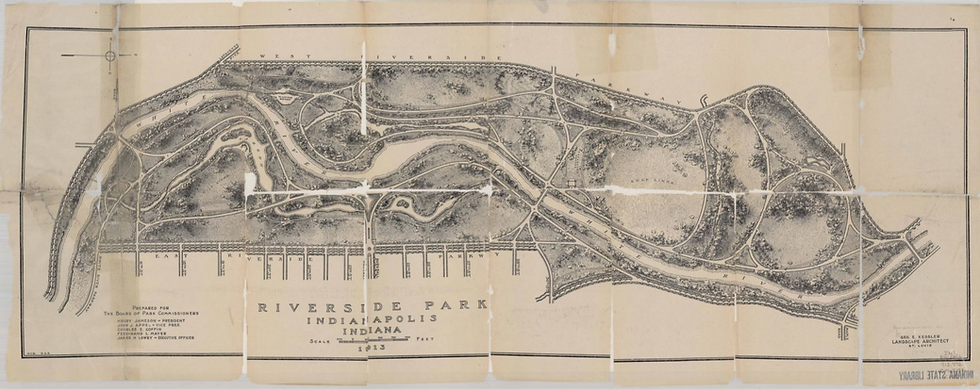
A link to the full map is here. The bridge location can be seen in the excerpt below. Note the "Indiana Canoe Club" to the left of the bridge.
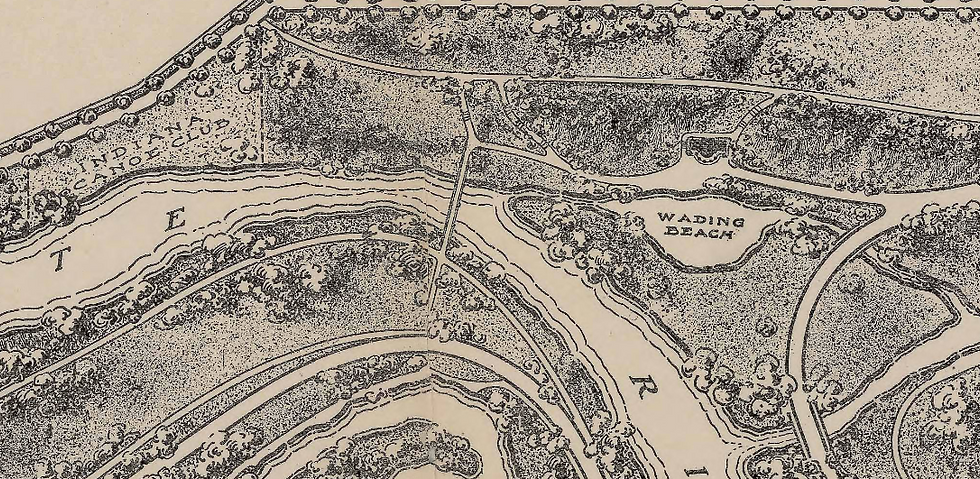
The 1915 annual report from the Board of Park Commissioners included a close-up image of the southern bridge, providing some detail on its towers and the bridge deck itself. It appears this image is taken from the west bank of the river looking east.

Eventually, the southern bridge also succumbed to ice on the river. In February of 1918 the Park Board was informed that the bridge had been destroyed by another ice jam. The city engineer reported that ice had undermined one of the piers for the bridge which caused its failure. The park board chose not to rebuild the bridge, and the iron parts of the bridge were scrapped.
Despite the destruction of both bridges, pieces of the structures remain. Most notable are parts of the northern bridge which are easily visible today. The piece pictured at the beginning of the post (as viewed from my kayak) is the eastern pier of the northern bridge. Additional photos are below. The righthand photo was taken in March of 2020, while the lefthand photo was taken this past weekend, and shows the impact of the new rock ramp dam, which has raised the water left upstream a few feet. Each of the two pedestals for the pier would support an iron lattice tower. If you look closely at the lefthand image, you can see the anchors for the bridge towers sticking out of the pier.
Also present on the eastern bank is the eastern anchorage for the suspension cables (also called an abutment in local sources), located literally one step off of the parking lot for the Lake Indy boat ramp.
The anchorage is in line with the abutment, and still has the remains of the heavy cabling, or maybe cable housing, which helped support the bridge. The decking for the bridge would have gone over the top of this concrete structure.
The western bank is part of Coffin Golf Course, and I did not have a chance to explore that area. Based on aerial imagery, there are no overt signs of the western anchorage. However, aerial images do show the remains of the western pier of the bridge, just under the surface of the river. Thanks to lower water during the past few years following the failure of the Emrichsville Dam, the water level was low enough to show the pier on aerial imagery. The image below is from 2021. The yellow arrow shows the pier pictured above, while the green arrow is the eastern anchorage. The red arrow points to the submerged western pier.

For the lower bridge, I explored the eastern bank of the river across from the Municipal Gardens looking for the southern bridge's eastern pier or anchorage, but the area is covered in heavy vegetation, and I found nothing. I will try the area again this once the vegetation is cleared. However, when I looked across the river from the eastern bank I was surprised to see the remains of the western pier in the shallow water just north of the Canoe Club and Municipal Gardens.
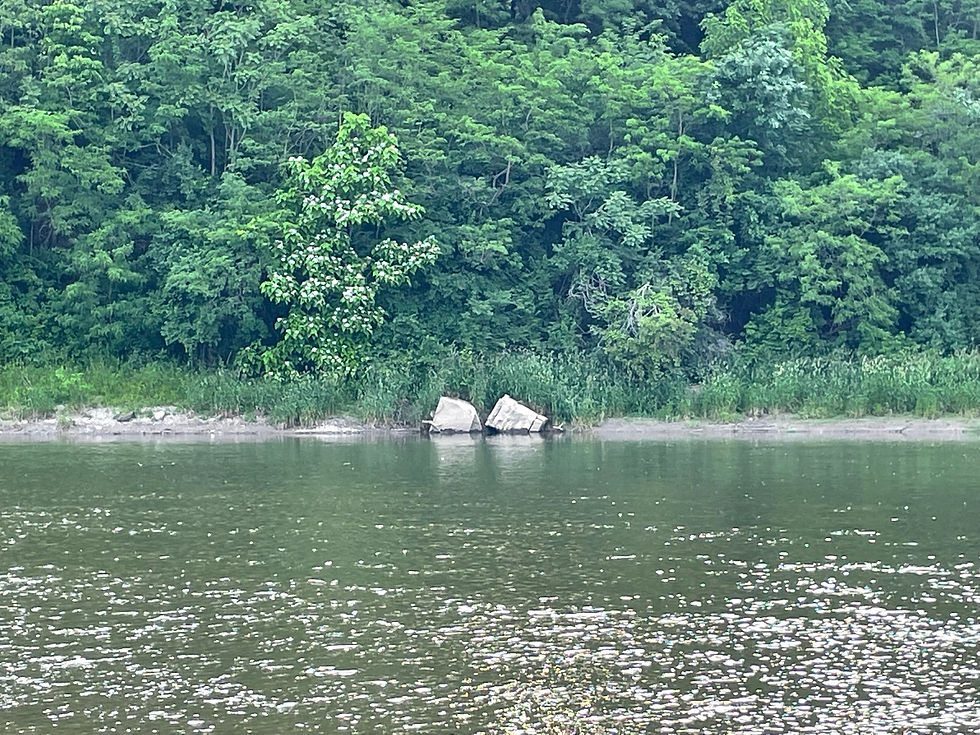
I think there may be part of the anchorage present just behind the remains of this pier on the Coffin, although I have not explored this site. In the next few weeks I will take my kayak down to this section of the river and explore the western bank for both the northern and southern bridges and update this posting if necessary.
While the suspension bridges have both been gone for more than 100 years, the Riverside Master Plan proposed several years ago included a new proposal for a pedestrian bridge as part of several improvements for the park. Based on the maps provided in the plan, one proposal is for the bridge to be placed on the site of the northern suspension bridge (see page 43 of the plan linked above), adjacent to the Lake Indy boat ramp.
Sources
Indianapolis News: June 30, 1899, August 14, 1900, July 12, 1901, August 22, 1901, January 22, 1904, March 15, 1904, March 3, 1905, February 15, 1918
Indianapolis Star: February 22, 1918
Indianapolis Journal: June 4, 1899, July 8, 1899
Suspension Bridge, Riverside Park, Indianapolis, Ralph W. Stark Heritage Center Lebanon Public Library, https://indianamemory.contentdm.oclc.org/digital/collection/p16066coll4/id/7850
Riverside Park Suspension Bridge, 1908 (Bass #B953), Indiana Historical Society, https://images.indianahistory.org/digital/collection/dc012/id/416/rec/6
Report of the Board of Park Commissioners for 1899, Digital Indy, https://www.digitalindy.org/digital/collection/ipr/id/35920/rec/3
Report of the Board of Park Commissioners for 1901, Digital Indy, https://www.digitalindy.org/digital/collection/ipr/id/35662/rec/10
Report of the Board of Park Commissioners for 1904, Digital Indy, https://www.digitalindy.org/digital/collection/ipr/id/35698/rec/2
Report of the Board of Park Commissioners for 1908, Digital Indy, https://www.digitalindy.org/digital/collection/ipr/id/36002/rec/9
Report of the Board of Park Commissioners for 1915, Digital Indy, https://www.digitalindy.org/digital/collection/ipr/id/131458/rec/6
Riverside Master Plan, https://www.riversideparkplan.com/









Maybe they should have gone with the higher bid!
Because of this post, I rode by and saw this bridge abutment and reflected on what it all must have been. That area has really changed. The entire Riverside area would be unrecognizable today to the citizen of 1922. One can only sit and contemplate.